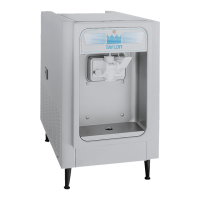24
Troubleshooting Guide
Models 150, 152, 162, 168
PROBLEM PROBABLE CAUSE REMEDY
13. Compressor starts but motor will
not get off s tart winding.
a. Low line voltage. a. Raise voltage.
b. Improperly wired. b. Check wiring against diagram.
14. Capacitor relay is inoperative. a. Defective relay. a. Replace.
b. Incorrect relay . b. Use relay properly selected for
motor characteristics.
15. Unit operates long or
continuously. Inferior product.
a. Shortage of refrigerant. a. Repair leak and recharge.
b. Dirty condenser. b. Clean the condenser.
c. Location is too warm. c. Change to a cooler location.
d. Starved evaporator. d. Keep correct mix level in hopper.
16. Head pressure is too high. a. Refrigerant is overcharged or
undercharged.
a. Correct the refrigerant charge.
b. Dirty condenser. b. Clean the condenser.
c. The location is too warm. c. Change to a cooler location.
d. The fan is not operating. d. Repair or replace.
17. Head pressure is too low. a. Refrigerant shortage. a. Repair leak.
b. Compressor suction or discharge
valves inefficient.
b. Replace c ompressor.
18. The compressor loses oil. a. Shortage of refrigerant. a. Repair leak.
b. Plugged expansion valve or
strainer.
b. Clean or replace.
19. Hot liquid line. a. Shortage of refrigerant. a. Repair leak.
20. Frosted liquid line. a. Restricted dryer or tubing. a. Replace or remove restrictions.
21. Excessive mix leakage through
rear of unit into drip pan.
a. Worn or missing drive shaft o-ring. a. Replace if worn, nicked, or
missing.
b. Inadequate lubrication of drive
shaft o-ring.
b. Lubricate properly.
c. Worn rear shell bearing. c. Replace rear shell bearing.
d. Incorrect o-ring on drive shaft. d. Replace with proper size o-ring.
e. Wrong type of lubricant was used. e. Use proper lubricant (example:
Taylor Lube).
22. Oil logged evaporator. a. Bent beater. a. Replace the beater.
b. Incorrect beater rotation. b. Refer to diagram.
c. Faulty expansion valve. c. Replace.
d. Starved evaporator. d. Keep suffic ient amount of mix in
hopper.

